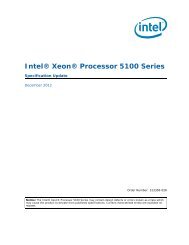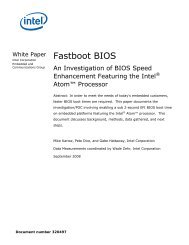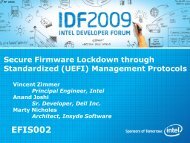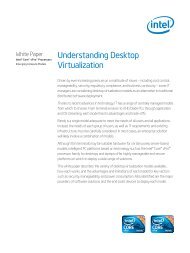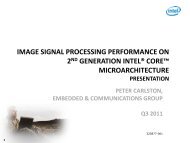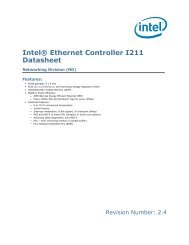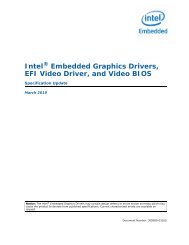Minimal Intel Architecture Boot Loader White Paper
Minimal Intel Architecture Boot Loader White Paper
Minimal Intel Architecture Boot Loader White Paper
You also want an ePaper? Increase the reach of your titles
YUMPU automatically turns print PDFs into web optimized ePapers that Google loves.
<strong>Minimal</strong> <strong>Boot</strong> <strong>Loader</strong> for <strong>Intel</strong>® <strong>Architecture</strong><br />
MRC Dependencies<br />
In order to use MRC distributed by <strong>Intel</strong>, care needs to be taken to provide<br />
the appropriate operating environment for the code. The operating<br />
environment requirements may include (but may not be limited to):<br />
<br />
<br />
<br />
Processor Operating Mode<br />
Cache Configuration<br />
Memory Geometry Information<br />
MRC may be written to run in 16-bit Real Mode, 32-bit Flat Mode, or<br />
(unlikely) a 32-bit Segmented Mode. If the adopted code does not have the<br />
appropriate operating environment, performance cannot be guaranteed.<br />
With the higher DRAM speeds and the need for RCOMP and DLL calibration,<br />
typical chipsets do not have enough scratchpad space in the register sets.<br />
Therefore, it is common for MRC to have cache configuration requirements,<br />
such that the MRC has a “chalkboard” to write on during initialization.<br />
PC-based memory configurations are based on removable memory modules<br />
(DIMMs). These configurations are dynamically detectable through tiny<br />
EPROM chips on the DIMMs. These chips contain specification-defined<br />
information about the capability of the DRAM configuration on the DIMM<br />
(Serial Presence Detect Data, or SPD data), and is readable through an I2C<br />
interface. For chipsets that are intended to be used in PC-based systems and<br />
support DIMMs, the MRC will usually have native SPD detection support<br />
included. For non-PC-based systems, it may not be present. In these<br />
configurations, it is required to hardcode the memory configuration or provide<br />
access to the memory geometry information through any vendor-defined<br />
mechanism. For memory-down designs, it may be necessary to generate<br />
several bytes of SPD data based on the DRAM datasheets and the schematics<br />
for the platform, and provide that to the MRC.<br />
All of these dependencies should be documented along with the code that<br />
comprises the MRC.<br />
Post Memory Initialization<br />
There are certain things that must be done after MRC but before jumping and<br />
executing from memory. The following is a list of things that should be<br />
performed:<br />
<br />
<br />
<br />
<br />
Memory Test<br />
Shadow Firmware<br />
Memory Transaction Re-Direction (PAMs)<br />
Stack Setup<br />
10




